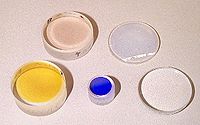
Photo from wikipedia
This paper attempts to identify key factor(s) for highly reflective silver (Ag) coatings. Investigation was made over the crystal orientation and surface roughness, using several types of surfaces, including electroplated… Click to show full abstract
This paper attempts to identify key factor(s) for highly reflective silver (Ag) coatings. Investigation was made over the crystal orientation and surface roughness, using several types of surfaces, including electroplated Ag polycrystal films, physical vapour deposited polycrystal Ag films, and single crystal Ag foils with different crystal orientations. In each type of the surfaces, surface roughness was varied so that, for different combinations of crystal orientation, roughness would elucidate the key factors towards highly reflective Ag coatings. It is found that surface roughness plays a critical role in determining the reflectance, while the crystal orientation has negligible effect. The mean reflectance and one-way ANOVA analysis indicate that the single crystal Ag foils with three orientations performed statistically the same in the same roughness group at significance level = 0.05. Moreover, correlation between the surface reflectance and surface roughness has been proposed for the benefit of coating design. Refection data obtained from the polycrystalline silver samples are used to verify the accuracy of the proposed correlations. It was observed that the development surface area ratio, , is a better roughness indicator in predicting the reflectance of polycrystalline silver films than the arithmetic average roughness, .
Journal Title: Advances in Materials Science and Engineering
Year Published: 2017
Link to full text (if available)
Share on Social Media: Sign Up to like & get
recommendations!